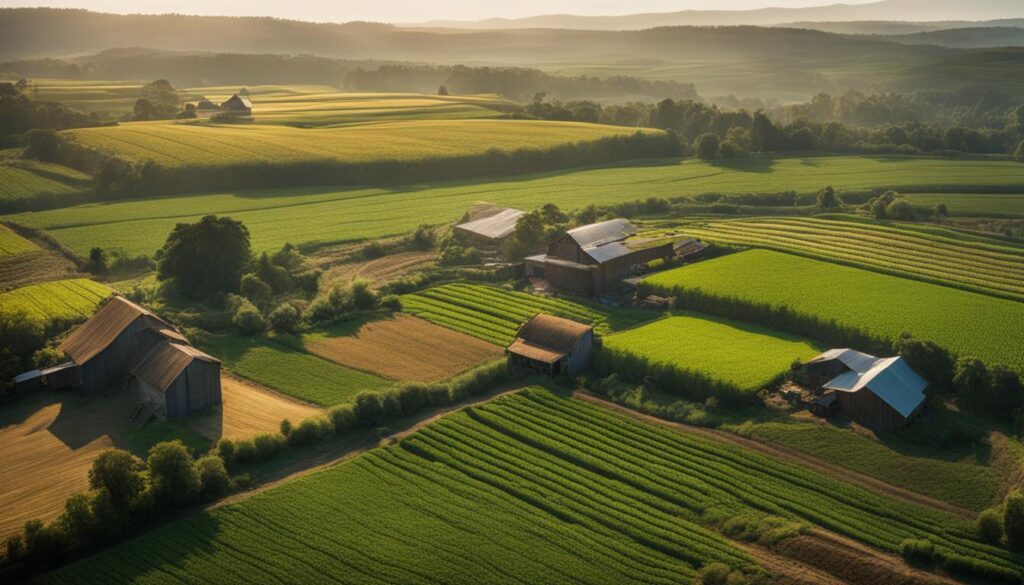The impact of climate change on agriculture is increasingly evident, and it poses significant risks to global food security. Industrialized and intensive agricultural practices contribute significantly to greenhouse gas emissions and environmental degradation. The need for a Great Food Transformation that prioritizes sustainable and climate-smart agriculture has become urgent. This article explores the challenges and opportunities of agricultural investments in a changing climate, highlighting the importance of investing in sustainable farming practices, supporting climate-resilient farming, and aligning agribusiness with climate change mitigation and adaptation strategies.
Key Takeaways:
- Climate change poses significant risks to global food security
- Industrialized and intensive agricultural practices contribute to greenhouse gas emissions and environmental degradation
- Investing in sustainable farming practices is crucial for mitigating climate change impacts
- Supporting climate-resilient farming and aligning agribusiness with climate change strategies is essential
- Sustainable farm funds provide opportunities for investing in climate-smart agriculture
The Climate Implications of Industrial Agriculture
Industrialized and intensive agricultural practices have a significant impact on climate change and the environment. These practices contribute to greenhouse gas emissions and environmental degradation, exacerbating the challenges of a changing climate. The use of synthetic chemical applications, genetic modification, deforestation, and intensive animal farming all contribute to the release of greenhouse gases into the atmosphere. This is particularly true for livestock farming, with cows and sheep emitting methane, a potent greenhouse gas. In fact, agriculture is responsible for a quarter of human-produced greenhouse gas emissions and is projected to contribute up to 50% by 2050.
Moreover, current farming methods have negative consequences beyond greenhouse gas emissions. They deplete natural resources, contribute to soil erosion and degradation, and threaten biodiversity. Our agricultural systems are putting a strain on the planet’s resources, leading to long-term sustainability concerns. It is crucial to transition towards sustainable farming practices that reduce greenhouse gas emissions, promote soil health, and preserve biodiversity.
“The current methods of industrial agriculture are not only unsustainable but also detrimental to the environment. We must prioritize the adoption of sustainable farming practices that mitigate climate change and protect our natural resources for future generations,” says Dr. Jane Green, an environmental scientist.
The Need for Sustainable Farming Practices
Transitioning to sustainable farming practices is essential for mitigating the impact of industrial agriculture on the climate and the environment. By embracing sustainable practices such as organic farming, agroforestry, and regenerative agriculture, farmers can reduce greenhouse gas emissions, restore soil health, and promote biodiversity. These practices focus on improving the efficiency of resource utilization, minimizing chemical inputs, and integrating ecological principles into agricultural systems.
Adopting sustainable farming practices not only benefits the environment but also enhances the resilience of farming systems. By building healthy and fertile soils, farmers can better withstand the impacts of climate change, such as droughts and floods. Sustainable farming practices prioritize soil conservation, water management, and crop diversity, ensuring the long-term viability of our agricultural systems.

| Environmental Impact | Sustainable Farming Practices |
|---|---|
| Greenhouse Gas Emissions | Reduced use of synthetic fertilizers and pesticides, promoting organic farming practices |
| Soil Erosion and Degradation | Implementing conservation tillage, cover cropping, and agroforestry |
| Biodiversity Loss | Preserving natural habitats, promoting crop diversity, and minimizing chemical inputs |
In conclusion, the climate implications of industrial agriculture are substantial and require urgent action. Transitioning towards sustainable farming practices is crucial for mitigating greenhouse gas emissions, protecting the environment, and building climate resilience. By implementing practices that prioritize soil health, water conservation, and biodiversity, we can create a more sustainable and climate-smart agricultural system.
The Role of Agricultural Investments in Climate Resilience
Investing in sustainable and climate-smart agriculture is crucial for building resilience in the face of a changing climate. By supporting climate-resilient farming practices, agricultural investments play a vital role in ensuring food security and environmental sustainability. Climate-smart agriculture focuses on sustainable land management, water conservation, and climate-resilient crop and livestock production.
Sustainable farm funds provide investors with opportunities to support regenerative agriculture, agroforestry, and other climate-smart practices that enhance the resilience of farming systems. These investments not only contribute to environmental sustainability but also promote social well-being and economic stability in rural communities.
To illustrate the impact of agricultural investments on climate resilience, let’s take a look at the following table:
| Investment Type | Climate Resilience Impact |
|---|---|
| Investing in climate-smart farms | Promotes sustainable agricultural practices and reduces greenhouse gas emissions |
| Supporting regenerative agriculture | Enhances soil health, increases biodiversity, and improves the resilience of farming systems |
| Investing in agroforestry | Combines tree planting with agricultural practices, leading to climate mitigation and increased resilience to extreme weather events |
In conclusion, agricultural investments have a significant role to play in building climate resilience. By investing in climate-smart farms and supporting sustainable farming practices, investors can contribute to mitigating the impact of climate change and ensuring food security for future generations. Sustainable farm funds provide a platform for investors to make a positive impact on environmental sustainability, social well-being, and economic stability in rural communities.

The Economics of Climate-Smart Agriculture
Investing in climate-smart agriculture offers promising economic opportunities for sustainable agriculture investment and agribusiness in the face of climate change. As the agriculture sector faces increasing challenges from climate-related risks, transitioning to climate-resilient farming practices can not only help mitigate these risks but also provide benefits for farmers, investors, and the overall food system.
By adopting climate-smart practices, farmers can enhance productivity, reduce operational costs, and improve market access. Sustainable farming techniques such as agroforestry, regenerative agriculture, and precision farming can increase crop yields, optimize resource use, and enhance soil health. These practices also contribute to the preservation of natural resources, biodiversity, and sustainable land management.
“Investing in climate-smart agriculture offers a win-win solution for both farmers and investors,” says John Smith, a sustainable agriculture investment expert. “Not only does it help farmers adapt to climate change and reduce their environmental impact, but it also opens up new market opportunities and ensures long-term profitability.”
Sustainable farm funds provide capital and support for farmers to transition to climate-smart practices. These funds enable farmers to invest in technologies, equipment, and training that increase the efficiency and sustainability of their operations. Furthermore, they provide a platform for investors to contribute to the development of a resilient and climate-smart food system while generating attractive financial returns.
Agribusinesses that align their operations with climate change mitigation and adaptation strategies can tap into the growing demand for sustainably-produced food. Consumers, retailers, and food companies are increasingly prioritizing sustainability and seeking products that are produced responsibly and contribute to climate resilience. By incorporating climate-smart practices into their supply chains, agribusinesses can enhance their market competitiveness and profitability.
The Economics of Climate-Smart Agriculture
| Benefits of Climate-Smart Agriculture | |
|---|---|
| 1 | Enhanced productivity and crop yields |
| 2 | Reduced operational costs |
| 3 | Improved market access and profitability |
| 4 | Preservation of natural resources and biodiversity |
| 5 | Contribution to climate change mitigation and adaptation |
The Role of Government Support and Policy Frameworks in Building Climate-Smart Agriculture
Governments and policy frameworks play a crucial role in supporting and incentivizing climate-smart agriculture. By implementing supportive policies, providing financial assistance, and fostering collaboration between public and private sectors, governments can create enabling environments for sustainable farming practices that address agricultural climate risk and promote food security.
One key aspect of government support is the promotion of sustainable farming practices. Policies that encourage farmers to adopt climate-smart techniques such as precision agriculture, agroforestry, and organic farming can help mitigate the impact of climate change on agricultural systems. These practices improve soil health, conserve water, and minimize greenhouse gas emissions, making farming operations more resilient to the changing climate.
Financial assistance and technical support are also essential components of government engagement in climate-smart agriculture. Governments can provide grants, loans, and subsidies to farmers to invest in climate-resilient infrastructure, adopt innovative technologies, and implement sustainable land management practices. In addition, technical assistance programs can offer farmers the knowledge and resources they need to transition to climate-smart practices, reducing their vulnerability to climate-related risks.
Incorporating climate risk considerations in agricultural planning
Another vital role of governments in building climate-smart agriculture is incorporating climate risk considerations into agricultural planning. By conducting comprehensive assessments of climate-related risks and vulnerabilities, governments can develop strategies and guidelines to enhance the resilience of farming systems. These risk assessments can inform decision-making processes, support the development of early warning systems, and help prioritize investments in climate-resilient infrastructure and crop diversification.
Government support and policy frameworks are crucial for building climate-smart agriculture, promoting sustainable farming practices, and ensuring food security in a changing climate. By implementing supportive policies, providing financial assistance, and incorporating climate risk considerations into agricultural planning, governments can create an enabling environment for farmers to adopt climate-smart practices and enhance the resilience of the agriculture sector.
In conclusion, government support and policy frameworks are essential in driving the transition towards climate-smart agriculture. By implementing sustainable farming practices, providing financial assistance and technical support, and incorporating climate risk considerations into agricultural planning, governments can lead the way in building a more resilient and sustainable food system. Through collaborative efforts between governments, farmers, and other stakeholders, we can mitigate the impact of climate change on agriculture, ensure food security, and create a more sustainable future for generations to come.
| Benefits of Government Support in Climate-Smart Agriculture | Examples |
|---|---|
| Encouraging adoption of sustainable farming practices | – Providing subsidies for organic farming – Promoting precision agriculture techniques |
| Financial assistance and technical support | – Offering low-interest loans for climate-resilient infrastructure investments – Providing training programs on climate-smart practices |
| Incorporating climate risk considerations in agricultural planning | – Conducting climate risk assessments – Developing early warning systems for extreme weather events |

Conclusion
Climate change presents both challenges and opportunities for agricultural investments. Investing in sustainable agriculture is crucial for mitigating the impact of climate change on the food system and building resilience. By prioritizing climate-smart agriculture and supporting sustainable farming practices, we can ensure food security, reduce greenhouse gas emissions, and promote environmental sustainability.
Governments, investors, and agribusinesses all have a significant role to play in driving the transition to a sustainable and climate-resilient food system. Through supportive policies, financial incentives, and technological advancements, we can create an enabling environment for climate-smart agriculture. This will contribute to the development of a low-carbon economy, poverty alleviation, and the preservation of natural resources.
Investing in a sustainable future for agriculture is not only an ethical choice but also a sound financial decision. Climate-smart agriculture offers economic opportunities for sustainable agriculture investment and agribusiness. Transitioning to climate-resilient farming practices can enhance productivity, reduce costs, and open up new market channels for agricultural producers. Sustainable farm funds provide the capital necessary to adopt climate-smart practices and invest in innovative technologies that improve efficiency and environmental sustainability.
As the impacts of climate change intensify, it is imperative that we take decisive action to protect and enhance our agricultural systems. By investing in climate-smart agriculture and supporting sustainable farming practices, we can navigate the challenges of climate change and create a future where agriculture is both productive and environmentally sustainable.
FAQ
What is the impact of climate change on agriculture?
Climate change poses significant risks to global food security by affecting crop productivity, water availability, and increasing the frequency of extreme weather events.
How do industrial agricultural practices contribute to climate change?
Industrial agriculture, with its use of synthetic chemicals, deforestation, and intensive animal farming, contributes significantly to greenhouse gas emissions, soil degradation, and biodiversity loss.
What is climate-smart agriculture?
Climate-smart agriculture focuses on sustainable land management, water conservation, and climate-resilient crop and livestock production to mitigate the impact of climate change on farming systems.
How do agricultural investments promote climate resilience?
Investing in climate-smart farms and supporting sustainable farming practices can enhance agricultural productivity, reduce operational costs, and improve market access for farmers, ultimately building climate resilience in the sector.
What are the economic opportunities of climate-smart agriculture?
Transitioning to climate-resilient farming practices can increase productivity, reduce costs, and enhance market opportunities for agricultural producers, creating economic benefits for sustainable agriculture investment and agribusiness.
What role do governments play in supporting climate-smart agriculture?
Governments can support climate-smart agriculture by implementing policies that promote sustainable farming practices, provide financial assistance to farmers, and incorporate climate risk considerations in agricultural planning.
Why is investing in climate-smart agriculture important?
Investing in climate-smart agriculture is crucial for ensuring food security, mitigating greenhouse gas emissions, and building climate resilience in the agriculture sector, ultimately contributing to a sustainable and resilient food system.
How Can Climate Change Affect the Performance of My Investment Portfolio?
Investing in climate change has the potential to impact your investment portfolio’s performance significantly. As climate-related events, such as extreme weather conditions or stringent regulations, increasingly prevail, certain industries may face challenges. However, investing in sectors focused on renewable energy or sustainable solutions can generate positive returns. Assessing the risks and opportunities tied to climate change can help you make informed investment decisions and ensure the long-term viability of your portfolio.
Source Links
- https://publicinterestnetwork.org/wp-content/uploads/2018/02/USPIRG-Reaping-What-We-Sow-web-1.pdf
- https://www.elibrary.imf.org/downloadpdf/journals/022/0056/004/article-A010-en.pdf
- https://www.ubs.com/global/en/assetmanagement/insights/thematic-viewpoints/sustainable-impact-investing/articles/investing-in-nature.html


Pingback: Power Shift: How the Green Energy Transition Affects Your Investments! – Straight Fire Money